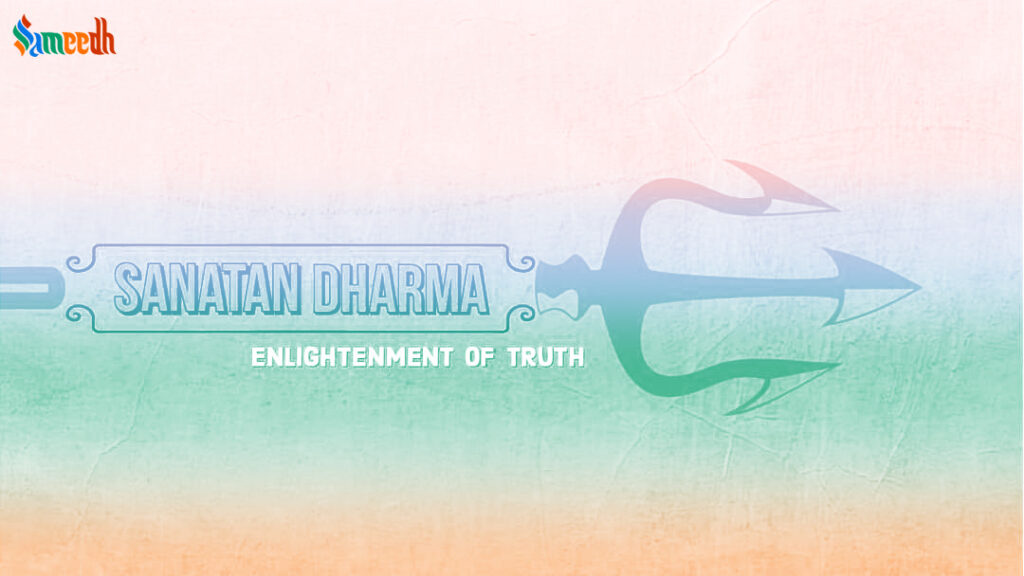Sanatana Dharma, often referred to as Hinduism, is one of the oldest religions in the world, with roots dating back thousands of years. “Sanatana” means eternal or everlasting, and “Dharma” can be translated as duty, righteousness, or the natural order of things.

Sanatana Dharma, often referred to as Hinduism, is one of the oldest religions in the world, with roots dating back thousands of years. “Sanatana” means eternal or everlasting, and “Dharma” can be translated as duty, righteousness, or the natural order of things. Thus, Sanatana Dharma can be understood as the eternal or timeless path or way of living in accordance with the natural order of the universe.
Sanatana Dharma encompasses a broad range of beliefs, practices, rituals, and philosophies, and it does not have a single founder or a centralized religious authority. Instead, it is a diverse and pluralistic tradition that incorporates a wide variety of religious, cultural, and philosophical elements.
Central to Sanatana Dharma is the belief in the concept of Atman (the individual soul) and Brahman (the ultimate reality or universal consciousness). It recognizes the existence of multiple gods and goddesses, each representing different aspects of the divine. Some of the major deities in Hinduism include Brahma (the creator), Vishnu (the preserver), Shiva (the destroyer), Lakshmi (goddess of wealth), Saraswati (goddess of knowledge), and Durga (goddess of power).
Sanatana Dharma emphasizes the pursuit of spiritual and moral duties (dharma), which vary according to one’s caste, age, gender, and occupation. It encourages individuals to lead a righteous life, fulfill their responsibilities, and seek liberation (moksha) from the cycle of birth, death, and rebirth (samsara).
The sacred texts of Hinduism, known as the Vedas and Upanishads, form the foundation of Sanatana Dharma. These texts contain hymns, rituals, philosophical discussions, and spiritual insights. Additionally, Hinduism also incorporates other scriptures, such as the Ramayana, Mahabharata (which includes the Bhagavad Gita), and Puranas.
It’s important to note that Hinduism is a vast and diverse tradition with various sects, schools of philosophy, and regional practices. The practices and beliefs can vary greatly among different individuals and communities within Hinduism.
Significance of Sanatan Dharma:
Sanatana Dharma, or Hinduism, holds significant importance in various aspects of life and spirituality. Here are some key aspects of its significance:
- Philosophical and Spiritual Guidance: Sanatana Dharma provides a comprehensive philosophical and spiritual framework that addresses the fundamental questions of human existence, the nature of reality, and the purpose of life. It offers profound insights into the nature of the self, the universe, and the ultimate reality.
- Diversity and Pluralism: Sanatana Dharma embraces diversity and pluralism, allowing for a wide range of beliefs, practices, and paths to spiritual realization. It recognizes that different individuals have unique spiritual inclinations and provides a multitude of approaches and traditions for them to explore and follow.
- Moral and Ethical Values: Sanatana Dharma emphasizes the importance of leading a righteous and ethical life. It promotes virtues such as honesty, compassion, self-discipline, and non-violence. The moral and ethical teachings of Hinduism guide individuals in their personal conduct and relationships with others.
- Rituals and Worship: Sanatana Dharma offers a rich tapestry of rituals and ceremonies that serve as a means to connect with the divine. These rituals provide a structured framework for expressing devotion, gratitude, and seeking blessings from the deities. They foster a sense of community and spirituality in Hindu society.
- Social and Cultural Integration: Sanatana Dharma plays a vital role in shaping the social and cultural fabric of Hindu communities. It provides a common framework of beliefs, values, and practices that unite people and promote harmony within society. Festivals, traditions, and customs associated with Hinduism foster a sense of collective identity and shared heritage.
- Liberation and Spiritual Evolution: Sanatana Dharma offers a path to liberation (moksha) from the cycle of birth, death, and rebirth. It provides spiritual practices, such as meditation, yoga, self-inquiry, and devotion, to help individuals attain self-realization and union with the divine. It encourages individuals to progress on the spiritual path and evolve spiritually.
- Preservation of Ancient Wisdom: Sanatana Dharma has preserved a vast body of ancient wisdom and knowledge through its sacred texts, such as the Vedas, Upanishads, and other scriptures. These texts contain profound insights into various aspects of life, including philosophy, spirituality, science, medicine, astrology, and more.
It’s important to note that the significance and interpretation of Sanatana Dharma may vary among different individuals and communities, and the above points provide a general overview of its importance.
